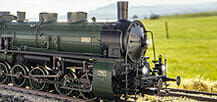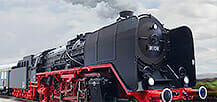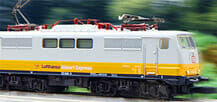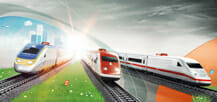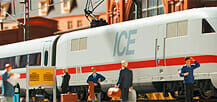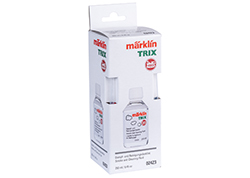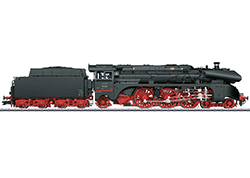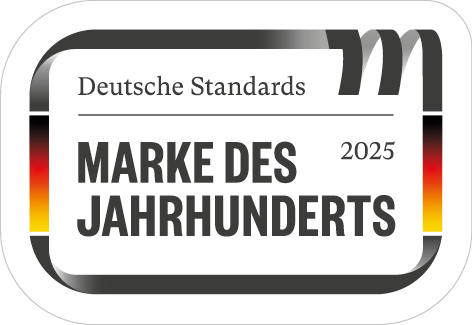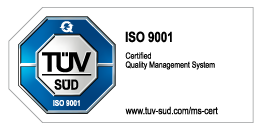Class 18 Steam Locomotive
A Tree Frog Writes History
It's December 16, 1960. On this day road number 18 314 rolled out on the tracks of the GDR State Railroad after an extensive overhaul as a gleaming green painted super steam locomotive. With a maximum speed of 150 km/h / 94 mph and a performance of almost 2,000 horsepower it was now the colorful streamlined star in the rather gloomy gray of the everyday GDR and soon acquired the nickname "Tree Frog". The unit belonged to Max Baumbergs "Zoo", as the locomotive roster for the Halle Research Institute (VES-M) was also called. It had previously written German-German history, when Baumberg, the subsequent VES-M manager, was able to pry the old four-cylinder Baden steam locomotive, road number 18 314, in 1948 from his university friend Theodor Düring in the Western zones. At that time, the high-stepping runner was initially called "Schorsch" probably due to the Bavarian smoke stack brim. In 1961 another green express locomotive joined the unit now called "Jimmo", road number 18 201, to go to the Halle "Zoo". From that time on the two streamlined one-of-a-kinds always attracted a lot of attention among the jet-black standard locomotives. Many anecdotes accumulated around Baumberg's green "animals". When road number 18 314 came out of the shops at some point with a thoroughly green paint scheme, nasty rumors went around that due to scarce resources only the dreary car green was available for the "Tree Frog". Nonetheless this locomotive is a unique one-of-a-kind.
Prototype: GDR German State Railroad (DR/GDR) express steam locomotive, road number 18 314, with coal firing and a type 2´2´T34 coal tender. Rebuilt version as an experimental locomotive of the VES-M Halle (Saale) (Railroad Research and Development Locomotive Management Department). Version with a "Reko" rebuilt boiler and partial streamlining, using the road number IVh as a basis (former Baden IV h). Witte smoke deflectors and inductive magnet on one side included. The locomotive looks as it did around 1962/1963.
Most Important Facts
Sound demo| Article No. | 55128 |
|---|---|
| Gauge / Design type | 1 / |
| Era | III |
| Kind | Steam Locomotives |
Highlights
- Completely new tooling.
- Highly detailed full metal construction.
- Frame, superstructure, boiler, etc. constructed of die-cast zinc, separately applied parts constructed of brass.
- Newly developed decoder generation with a current buffer and up to 32 functions.
- Smoke unit with smoke exhaust and f/r cylinder steam synchronized with the wheels and a steam whistle.
- Special function: The locomotive engineer activates the controller (servo activated)
- Load-controlled operating sounds synchronized with the wheels.
- Smoke box door and dome hatches can be opened, many original details included.
- Headlights with a light color correct for the era and warm white LEDs.
- Red marker light that can be controlled.
- Cab lighting.
- mfx decoder for operation with AC power, DC power, Märklin Digital, and DCC.
- Valve gear switchover (forward, reverse, continuous operation) in 3 steps with a servomotor.
- Telex coupler on the rear, reproduction prototype coupler on the front (1 more of each included with the locomotive).
-
Product description
Model: The locomotive is constructed mostly of metal. The frame, locomotive body with boiler, and the cab are constructed of die-cast zinc. Other separately applied parts are mostly constructed of metal (brass). This is an extensive model with many separately applied elements and a highly detailed cab. The smoke box door can be opened. The cab doors and much more can be opened. The locomotive has an mfx digital decoder with 32 functions, controlled high efficiency propulsion, and a sound generator with operating sounds synchronized with the wheels as well as extensive sound functions. It can be operated with AC power, DC power, Märklin Digital, and DCC. The locomotive has a built-in buffer capacitor. All driving axles powered. The locomotive has a built-in smoke unit with smoke exhaust and multi-step cylinder steam synchronized with the wheels and a steam whistle. The locomotive has running gear lights and triple headlights with a light color correct for the era and that change over with the direction of travel. The headlights will work in conventional operation and can be controlled digitally. Maintenance-free, warm white LEDs are used for the lighting.
The locomotive has a red marker light that can be controlled and cab lighting. Digitally controlled special function: The locomotive engineer activates the controller (movement activated with a servo as when the locomotive engineer activates the controller in real life). The locomotive comes with sprung buffers. There is a reproduction of the prototype coupler on the front and a remote-controlled Telex coupler on the rear of the tender, which can be replaced by the other type of coupler. The valve gear switchover is in 3 steps (forward, reverse, continuous operation). There is a built-in figure of a locomotive engineer and a fireman.
An accessory package with a reproduction of the prototype coupler, smoke fluid, and gloves is included with the locomotive. The locomotive is mounted on an aluminum base painted black for display purposes. Minimum radius for operation 1,020 mm / 40-3/16". Length over the buffers approximately 73.8 cm / 29". Weight approximately 9.2 kilograms / 20 pounds 4 ounces.Find more Märklin explanation videos on our YouTube Channel
Spare parts for our articles can be found here in our spare parts search.
-
Publications
- Fall New Items 2025 - Product programme 2025/2026
-
Prototype information
How one of 20 IV h locomotives originally built in Baden ended up in the GDR as part of the later 18.3 series for the Deutsche Reichsbahn (DR). In the spring of 1945, the Deutsche Reichsbahn-Gesellschaft (DRG) had all 19 remaining Class 18.3 locomotives transported from their home depot at Bremen Central Station, which they had occupied since 1942, to the Munster-Lager military railway station on the edge of the Lüneburg Heath in order to protect them from the destruction of war. to the military railway station in Munster-Lager on the edge of the Lüneburg Heath in order to protect them from the destruction of the war. Thus, 18 314 also experienced the end of the war there. From 1946 to 1947, it was the last locomotive of its class to be back in service at Bremen Central Station. At the end of the 1940s, the DR needed high-speed locomotives to test newly developed railway cars. Engineer Max Baumberg, head of the Testing and Development Center for Machine Management (VES-M) in Halle, approached the main administration of the railways in the western occupation zone, specifically his college friend Theodor Düring, with a view to procuring a high-speed locomotive. Düring held the same position in the FRG that Baumberg had in the GDR, as head of the Federal Railway Testing Office in Minden (Westphalia). Baumberg's intention was to exchange the 18 434 (formerly Bavarian S 3/6), which had remained at the Erfurt-P. depot after the end of the war, for a Baden IV h. He was successful, and Baumberg received the 18 314 in April 1948. Through this locomotive exchange, the four-cylinder Baden locomotive made German-German history. Its first task at the DR was to transport courier trains for the Reichsbahn repair workshop (RAW) in Stendal. In the 1950s, it underwent its first modification with the addition of the “Bavarian crown,” the Caledonian crown of a Bavarian S 3/6 (later BR 18.4-6), and presumably received the nickname “Schorsch” because of this. When the GDR began manufacturing passenger cars with a maximum speed of 160 km/h for export to Russia in the late 1950s, appropriate locomotives were needed to test them. It was therefore decided to carry out a fundamental reconstruction of the 18 314, which was taken out of service in December 1959 and sent to the RAW “7. Oktober” workshop in Zwickau. It was December 16, 1960. On this day, after an extensive rejuvenation and due to its special purpose, the super steam locomotive, painted bright green with a gray-white longitudinal stripe and a chrome ring under the Caledonian brim, rolled onto the tracks of the GDR Reichsbahn. The machine was given its striking appearance with streamlined contours. With a top speed of 150 km/h and an output of almost 2000 hp, it was now the colorful streamlined star in the rather dreary gray of everyday life in the GDR and soon earned the nickname “Laubfrosch” (tree frog). The machine belonged to Max Baumberg's “zoo,” as the VES-M locomotive park was also known. The conversion made the 18 314 the most powerful locomotive in its series. In 1961, another green high-speed locomotive, the 18 201, known as the “Jimmo,” joined the Halle “zoo.” From then on, the two sleek loners repeatedly caused a sensation amid the jet-black standard locomotives. This brings us to the operational status of our 1962/63 model. At that time, 18 314 was assigned to an express train schedule at the Halle-P depot, where the test and trial runs required for new vehicles were naturally carried out. Its planned main route was the Saalfeld–Eisenach–Halle–Berlin line. And there were many anecdotes surrounding Baumberg's green “animals.” When 18 314 emerged from the workshop at some point with a much darker green color, malicious tongues rumored that the “tree frog” had only been given the dull wagon green due to the shortage economy. Nevertheless, the locomotive is a unique specimen with remarkable achievements and stories. We took all this as an opportunity to give this locomotive the highest model honor in the king's gauge. We have incorporated all the modifications that the locomotive underwent during reconstruction into our model with its numerous light and sound functions and its design language that corresponds exactly to the prototype. Just imagine if this high-performance racer, which has been upgraded to a high-speed locomotive by the engineers at RAW, were to run on your layout with a heavy express train or as an “Lz” (locomotive train) in your display case... When the locomotive driver operates the side lever, the powerful four-cylinder compound engine surges forward, marching on, and – to use the jargon of a real railwayman – the quadruple, the internal engine, rotates around the throat axle. Acoustically and visually superb, with the appropriate locomotive sound and a load-dependent, multi-stage, dynamic steam output implemented by the designers at the Göppingen dream factory! The experience of “Schorsch – Germany's last country railway Pacific in trial service at the VES-M Halle” can be enjoyed in all areas thanks to the 1:32 scale model, which is sure to captivate every railway enthusiast!
-
Digital Functions
Control Unit Mobile Station Mobile Station 2 Central Station 1/2 Central Station 3/2*
Mobile Station 2**Headlight(s) Smoke generator Steam locomotive op. sounds Locomotive whistle Telex coupler on the rear Engineer’s cab lighting Sanding Special Function Direct control Sound of squealing brakes off Switching range + switching light Light Function Light Function Injectors Water Pump Sound of coal being shoveled Marker light(s) Whistle for switching maneuver Conductor's Whistle Letting off Steam Air Pump Surrounding sounds Safety Valve Tipping grate Special sound function Replenishing fuel Replenishing water Replenishing sand Switching maneuver Rail Joints Special sound function Special sound function * New features of the Central Station 2 (Part No. 60213, 60214 or 60215) with the software update 4.2
** New features of the Mobile Station 2 (Part No. 60657/66955) with the Software Update 3.55
Warning
ATTENTION: not for children under 15 years
